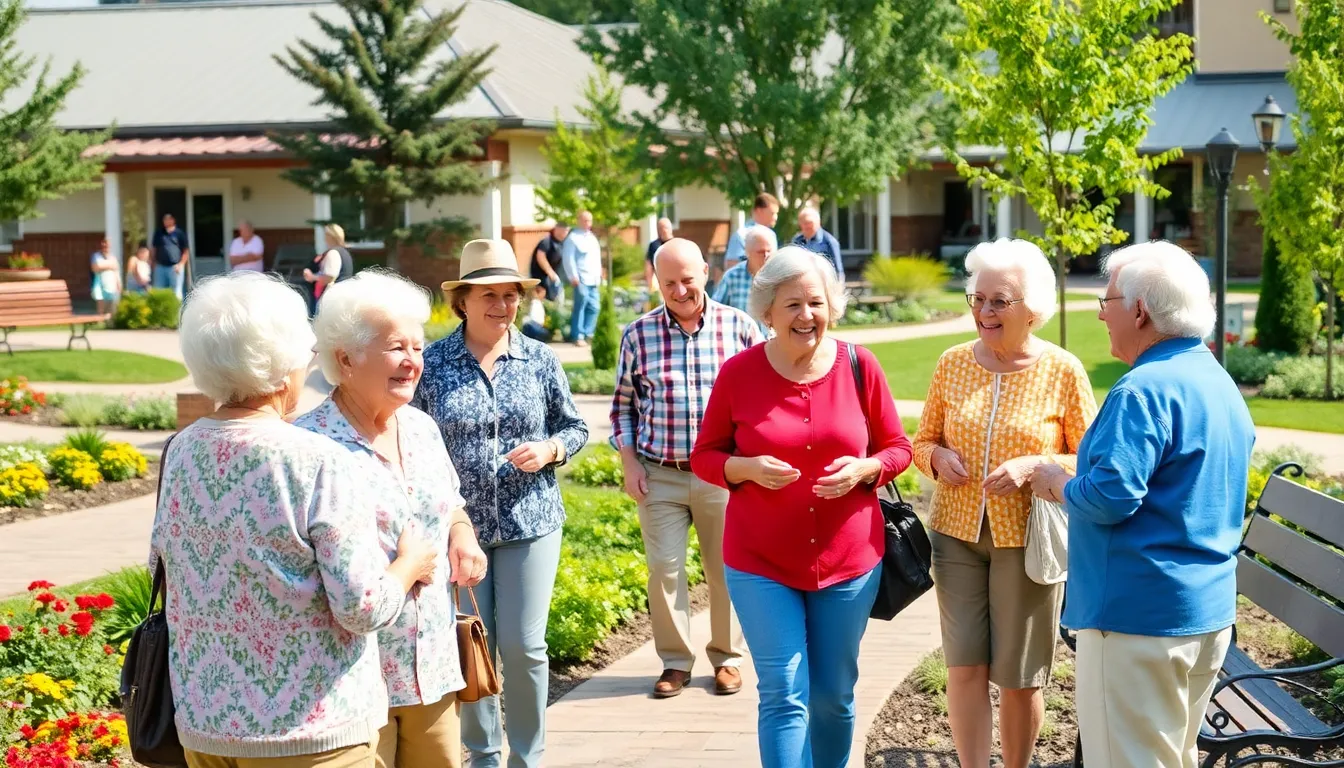Table of Contents
ToggleRetirement communities are like the ultimate playground for adults—minus the swings but with plenty of bingo. As people step into this exciting new chapter of life, they often discover that these vibrant communities offer more than just a roof over their heads. With a range of activities, social opportunities, and amenities, they’re designed to keep spirits high and boredom at bay.
Overview of Retirement Communities
Retirement communities serve as vibrant environments designed specifically for older adults. These communities offer an array of amenities such as fitness centers, swimming pools, and hobby workshops, ensuring that residents lead active lives. Social events and organized activities foster engagement among neighbors, creating a sense of belonging.
Communities vary in structures and styles, ranging from independent living to assisted and continuing care facilities. Independent living caters to seniors seeking autonomy, while assisted living provides necessary personal care. Continuous care communities offer comprehensive support, adapting to changing health needs.
Safety and security are prioritized within these communities. Many feature gated entrances, security personnel, and emergency response systems, allowing residents to feel secure. On-site healthcare services often enhance peace of mind, providing immediate medical assistance when needed.
Choosing a retirement community involves evaluating lifestyle preferences and needs. Factors like location, community size, and available activities significantly influence satisfaction. While some individuals prioritize proximity to family or favorite attractions, others may focus on the social atmosphere and programs.
Costs associated with retirement communities vary widely. Monthly fees typically cover housing, maintenance, and amenities. Understanding the financial obligations helps individuals make informed decisions about their futures.
Retirement communities offer much more than housing. They provide opportunities for social interaction, physical activity, and overall well-being, enhancing quality of life for older adults.
Types of Retirement Communities

Various types of retirement communities cater to different needs and preferences, ensuring a suitable living environment for each individual. These communities range from those that emphasize independence to those that offer more comprehensive care.
Independent Living Communities
Independent living communities provide adults with the freedom to maintain their lifestyle while enjoying various amenities. Residents here typically live in private apartments or cottages, allowing for personal space and autonomy. Regular social activities, outings, and wellness programs foster an engaging environment. Many facilities offer meals, transportation options, and maintenance services, simplifying daily life. This type of community appeals to active seniors seeking a vibrant lifestyle without the burdens of homeownership.
Assisted Living Facilities
Assisted living facilities support seniors who require help with daily tasks but wish to retain their independence. Trained staff provides assistance with activities like bathing, dressing, and medication management. Each resident enjoys a private or shared living space, ensuring privacy and comfort. Many facilities feature recreational activities and wellness programs to promote socialization and overall well-being. These communities create a balance between autonomy and necessary support, meeting the needs of individuals with varying levels of care.
Continuing Care Retirement Communities
Continuing care retirement communities offer a range of accommodations and services to meet changing needs. These facilities combine independent living, assisted living, and skilled nursing care within one community. Residents can transition between levels of care without needing to relocate, ensuring continuity in their support system. This model allows for personalization in care plans, accommodating both active lifestyles and increased health care needs over time. Many participate in various activities and wellness programs, emphasizing a holistic approach to aging in place.
Benefits of Retirement Communities
Retirement communities offer significant advantages for older adults. These benefits enhance daily living, ensuring residents enjoy their later years to the fullest.
Social Engagement Opportunities
Social interaction plays a vital role in emotional well-being. Residents participate in group activities such as game nights, art classes, and social gatherings. These events foster relationships, creating a sense of belonging. Many communities organize outings to cultural events, encouraging exploration and connection with the broader community. Accessible environments support friendships, making it easier to bond with neighbors.
Access to Healthcare Services
Healthcare accessibility is critical in retirement communities. On-site health services provide immediate assistance with medical needs. Regular wellness check-ups ensure residents maintain good health. Some facilities offer personalized care plans, addressing individual requirements. Emergency response systems provide peace of mind, allowing residents to feel safe knowing help is nearby. Access to medical professionals enhances overall well-being and supports an active lifestyle.
Maintenance-Free Living
Maintenance-free living simplifies daily life for residents. Professional staff handle chores like landscaping, housekeeping, and home repairs, allowing individuals to focus on enjoying life. Many communities also offer dining services, providing healthy meal options without the hassle of cooking. Residents appreciate the freedom from household responsibilities, which leads to increased leisure time. This benefit promotes an active lifestyle, encouraging participation in activities without daily distractions.
Considerations When Choosing a Retirement Community
Choosing a retirement community requires careful evaluation of several key factors. Each consideration impacts overall satisfaction and comfort in the new living environment.
Location and Accessibility
Location plays a crucial role in ensuring convenience. Residents prioritize communities close to family, friends, and essential services such as grocery stores and hospitals. Accessibility matters, too; communities with easy access to public transportation enhance mobility for those who no longer drive. Safety in the surrounding area also contributes to peace of mind, ensuring residents feel secure in their new surroundings.
Costs and Financial Planning
Understanding costs is vital in the decision-making process. Fees for retirement communities vary significantly depending on location, amenities, and services offered. Monthly charges typically include housing, utilities, and access to activities. Financial planning should involve a thorough examination of all costs, including potential long-term expenses like healthcare. Exploring financial assistance options, such as veterans’ benefits or state programs, can also make transitions more manageable.
Amenities and Services Offered
Amenities influence lifestyle quality and satisfaction. Many communities provide fitness centers, pools, and clubhouses filled with recreational opportunities for social engagement. Wellness programs form an essential part of the services offered, further supporting residents’ health and well-being. Access to on-site medical care, transportation services, and social activities enhances residents’ experiences, fostering a vibrant community atmosphere.
Retirement communities offer a vibrant lifestyle that enhances the well-being of older adults. With a range of activities and amenities designed to promote social engagement and physical health, these communities provide an enriching environment.
Safety and security are prioritized, ensuring residents can enjoy their independence without worry. As individuals weigh their options, understanding the various types of communities and their offerings is crucial.
Ultimately, retirement communities are not just about housing; they represent a lifestyle choice that fosters connection, support, and fulfillment in later years. Choosing the right community can lead to a happier and more satisfying retirement experience.






